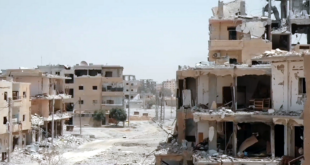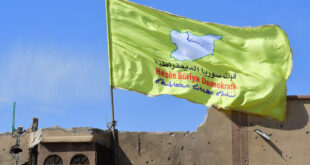Russia is trying to extort the Syrian Democratic Forces in northeast Syria by threatening to retreat from its locations and leave the SDF at the mercy of the threats of the Turkish army and its allies, if the SDF does not respond to Russia’s demands and interests.
The Turkish army and Russian forces’ recent military moves have raised the concerns of the Syrian Democratic Forces (SDF) in Hasakah and Raqqa in northeastern Syria.
The SDF is concerned about falling victim to a possible deal between Russia and Turkey after the 15th round of the Astana negotiations held in the Russian city of Sochi on Feb. 16-17, in the presence of representatives of the three guarantors of the cease-fire in Syria — Russia, Turkey and Iran — and with the participation of two delegations from the Syrian army and opposition.
On Feb. 21, Russian forces retreated from their base in Ain Issa in northern Raqqa, which is under SDF control, and moved to their military base in Tel al-Saman, 22 kilometers (14 miles) to the southeast of Ain Issa. But the Russian forces returned Feb. 22 to their locations in Ain Issa, which Turkey is threatening to attack through its allied the Free Syrian Army (FSA) factions. The Russian forces also partially withdrew from their military base in Tel Tamr in the countryside of Hasakah, before shortly returning to it.
A media activist from Ain Aissa, speaking on condition of anonymity for security purposes, told Al-Monitor, “The temporary retreat of the Russian forces from their bases in Ain Issa in northern Raqqa and Tel Tamr in Hasakah countryside stems from the SDF’s violation of the Russian orders to de-escalate the situation on the fronts with the Turkish army and the FSA as clashes and shelling continued on several axes. This may be the most common justification [for the Russian withdrawal], but I think the reasons behind the retreat from the bases and the subsequent return to them is more complicated. Russia is trying to extort the SDF and pressure it through these military moves.”
Istanbul-based military analyst Ahmed Mohammed Hamada told Al-Monitor, “The retreat of the Russian forces seemed to be a mere formality since their military positions and bases remained in place, along with the Russian soldiers inside. Russia is trying to extort the SDF by threatening to leave the Ain Issa front open to Turkish threats if the SDF does not respond to Russian pressure and resolve the Ain Issa issue once and for all. Russia wants the Syrian regime to control the area completely. If the SDF insists on its stance to refuse the regime’s control, the Russian military forces will escalate in the region, and the retreat operations might recur more widely in the coming phase. Turkey would in turn make military moves to pressure the SDF and perhaps to wage a battle against it.”
Mostafa Bakkour, a military researcher and analyst residing in Idlib in northwest Syria, told Al-Monitor, “History has shown that Russians and Turks implement the results of the Astana negotiations on the ground immediately after the talks’ conclusion, without announcing the agreements reached.”
Bakkour added, “I think what is happening falls in the framework of a Russian-Turkish agreement to undermine the SDF in the region, especially after the Russian-brokered negotiations between the SDF and the Syrian regime failed. It is noteworthy that the US forces brought in new military hardware into the SDF-controlled areas in northeast Syria, including air defense missiles. This portends that the situation will become more complex in the coming phase.”
Russian and Turkish forces in Hasakah reached in mid-February an agreement to move grains from the Sharkrak silos to Syrian regime-controlled areas. The Russian Rusvesna website said Feb. 18 that a group of Russian forces in Hasakah brokered an agreement between the Syrian government and Turkey to move part of the grain reserves from those silos to the regime-controlled areas in Aleppo.
The Turkish Defense Ministry published a video Feb. 19 showing dozens of trucks lined up in front of silos and being loaded with grains. The ministry said in a tweet, “The step was taken in agreement with Russia.”
The latest Russian military moves in the SDF-controlled areas in northeast Syria seem to aim at achieving some gains, mainly settling the Ain Issa issue and keeping the SDF away from the M4 international highway, dispelling Turkey’s fears by keeping the SDF away from the strategic area and facilitating trade movement between northeast Syria and Aleppo. These endeavors are part of Russian efforts to revive the Syrian regime’s collapsing economy. Russia’s presumed extortion of the SDF aims at pressuring it into halting its siege of Syrian regime areas in Hasakah and Qamishli. Russia also wants to push the SDF to continue supplying the regime with oil and seeks to revive the economy of the regime or help it survive at least until the presidential elections that are to take place in a few months.
Russia has taken advantage of the troubled situation in the SDF-controlled areas in northeastern Syria to expand and cement its presence, specifically in oil-rich Hasakah. Russian forces turned the Qamishli airport into a military base. The current Russian military moves cannot be taken out of the general context in northern Syria, amid the increasing competition between Turkey, Russia and the United States to confirm their presence and entrench their influence in the most important and complex Syrian areas.
 Eurasia Press & News
Eurasia Press & News




